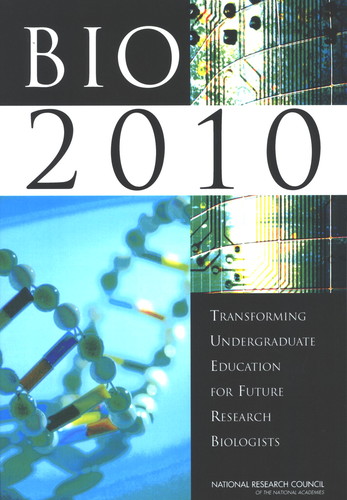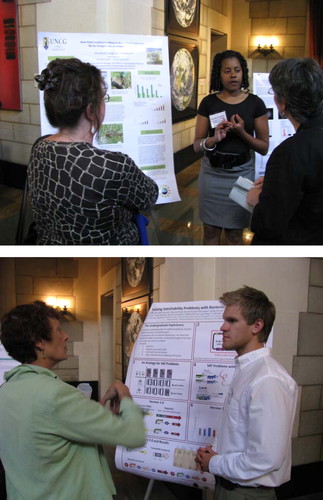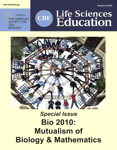“Beyond BIO2010: Celebration and Opportunities” at the Intersection of Mathematics and Biology
With this special edition of CBE-LSE, which focuses on connections between and integration of the biological and mathematical sciences, it is especially fitting that we report on an important symposium, Beyond BIO2010: Celebration and Opportunities,1 which was held at the National Academy of Sciences (NAS) in Washington, D.C. on May 21–22, 2010. This symposium was organized to assess what progress has been made in addressing the challenges and recommendations in the National Research Council's (NRC) report: BIO2010: Transforming Undergraduate Education for Future Research Biologists (NRC, 2003a). Most of the presentations and posters at this event emphasized the increasing connections of the life and mathematical sciences in undergraduate education. The symposium was initiated by the U.S. National Committee to the International Union of Biological Sciences and was hosted by the National Academies' Board on Life Sciences.2
The original NRC BIO2010 report (Figure 1) emphasized the interdisciplinary nature of scientific investigation, calling for a greater degree of integration between biology, chemistry, physics, mathematics, engineering, and computer science classes. The report recognized that teaching through this new interdisciplinary perspective requires new materials and approaches—as well as faculty development efforts to help instructional staff to develop their own skills. Biology students at all levels are to be encouraged to pursue independent research and engage in laboratory courses and seminar experiences. Finally, the report acknowledged as problematic the impact of medical school admissions requirements and the Medical College Admissions Test (MCAT) on implementing such changes to undergraduate biology education. Indeed, a report commissioned by the Association of American Medical Colleges (AAMC) and Howard Hughes Medical Institute (HHMI; 2009) has recommended a fresh look, including new mathematical competencies for the preparation of future physicians.
Figure 1. The cover of the NRC (2003) report BIO2010: Transforming Undergraduate Education for Future Research Biologists.
Those working at the intersection of the life and computational sciences have been particularly receptive to the recommendations of BIO2010. Math & Bio2010: Linking Undergraduate Disciplines (Steen, 2005) built on BIO2010 to offer additional guidance specific to the intersection of biology, mathematics, and computer sciences. The symposium highlighted a number of recent advances:
New approaches to teaching and pedagogy: Approaches are being developed that incorporate rigorous mathematical, physical, and informational sciences into biology, cross-disciplinary, and interdisciplinary courses. A noted example is a case study in which the mechanism of influenza infection is used to motivate investigation of carbohydrate chemistry.
Cross-disciplinary faculty collaborations: Faculty are working together to introduce concepts and topics in the mathematical, physical, and informational sciences into biology courses and vice versa.
Undergraduate laboratory experiences: Cross-disciplinary study also is being extended to the student laboratory. Interdisciplinary laboratory experiments are incorporating a discovery approach.
Undergraduate research experiences: Student independent research is being promoted as early as possible. Students' scientific communication skills should be enhanced through presentations of their research.
Assessment and evaluation: Implementation of the BIO2010 recommendations should be accompanied by proper assessment of achievement of pedagogical goals (Slonczewski and Marusak, 2004).
This meeting celebrated the significant progress that has been made through the mutual effort of biologists and mathematicians to develop new curricular materials, majors, collaborative research initiatives, national institutes, professional development workshops, journals, national science digital libraries, awards, etc.
Eight pairs of a biologist and a mathematician or computer scientist presented reports based on such collaborations. These included: Raina Robeva and Robin Davies, Sweet Briar College (VA); Glenn Ledder and Brigitte Tenhumberg, University of Nebraska; Chris Leary and Jennifer Apple, State University of New York at Geneseo; Anton Weisstein, Truman State University (MO), and Gretchen Koch, Goucher College (MD); Kam Dahlquist and John Dionisio, Loyola Marymount University (CA); Terry Derting and Renee Fister, Murray State University (KY); Katerina (Kaci) Thompson and Karen Nelson, University of Maryland, College Park; and A. Malcolm Campbell and Laurie Heyer, Davidson College (NC).
All presenters had implemented their innovations and were asked to elucidate their strategies for assessment and to address how their efforts might be transferable and amenable to adoption or adaptation.
In each case, the closeness, richness, and sustained nature of their collaborations were self-evident through presenters' seamless integration of both subjects and the obvious mutual interest in one another's work, coauthored publications and joint grants, software, and other professional products. The impact of their collaborations on engaging students in interdisciplinary research, transforming both content and pedagogy in a variety of existing courses as well as developing new courses, encouraging biology students to take more mathematics and mathematics students to take more biology, and affecting the postbaccalaureate career choices of their graduates, was apparent. Three of these collaborations have produced textbooks in biomathematics (Robeva et al., 2008), bioinformatics (Campbell and Heyer, 2006), and microbiology (Jungck et al., 2009); several have generated substantial software and interactive websites that are freely available;3 and one has built a model of open education based on the open source–open science movement.4 All addressed the need for analyzing much more complex data than used in previous biology and mathematics programs. All employed technology extensively, and alternative pedagogies that were more learner-centered and based on “how students learn.”
Of note, Brynja Kohler, a mathematics education professor at Utah State University, reported on “A Collaborative, Project-Based Approach to Biomathematics,” which she initiated with colleagues in Biology (Jim Haefner) and Mathematics (Jim Powell). They introduced sophisticated mathematical analyses and modeling projects into beginning biology labs (Kohler et al., 2010). John Milton (Professor of Computational Neuroscience in the joint science department of Claremont/McKenna, Pitzer, and Scripps Colleges) reported on multiple initiatives in mathematical biology, including a program that sends teams of undergraduate research students out to industrial sites to solve applied problems.5
These interdisciplinary approaches to undergraduate education are benefiting students from traditionally underrepresented student populations. C. Dinitra White, a computational biologist, described how she and Greg Goins, an environmental biology colleague, implemented a program in mathematical biology at North Carolina's A&T State University (a Historically Black University) that successfully engaged students in pursuing careers in science, technology, engineering, and mathematics (STEM). Two biologists, Michelle Borrero and Migdalisel Colon, from the University of Puerto Rico - Rio Piedras, shared how their new, more quantitative curricula improved their students' general conceptual understanding of both biology and hypothesis testing.
Representatives from the National Science Foundation (NSF) and the National Institutes of Health (NIH) summarized a number of opportunities and programs supported by these agencies that have enabled many more minority students to explore careers in the quantitative life sciences. Marilyn Suiter (Education and Human Resources Directorate at NSF) highlighted the Historically Black Colleges and Universities Undergraduate Program (HBCU-UP),6 which has been very successful in engaging students in interdisciplinary research. Shawn Drew (Minority Access to Research Careers [MARC], NIH Division of Minority Opportunities in Research) spoke on “MARC U-STAR: Implementing Bio2010 Recommendations.”7
Presentations about individual initiatives were preceded by and interspersed with speakers who were asked to provide broader contexts for the work. Claudia Neuhauser (University of Minnesota-Rochester [UM-R]), who served on the panel that produced a report commissioned by the AAMC and HHMI (2009), which recommended new mathematical competencies for the preparation of future physicians, is developing curriculum to engage UM-R students in tackling Mayo Clinic's challenging biomedical problems in a project called NUMB3R5 COUNT.8 Professor Lou Gross (Director of the National Institute for Mathematical and Biological Synthesis) challenged symposium participants to be much more data-intensive in both biology and mathematics classes.9 HHMI Vice President Peter Bruns described the success of The National Academies Summer Institute on Undergraduate Education in Biology (held annually at the University of Wisconsin) in engaging research university faculty in curriculum reform that addresses challenges identified in BIO2010.10
Brad Williamson, from the UKanTeach Program at the University of Kansas, reported that the forthcoming Advanced Placement examination in biology will be much more quantitative than in the past (e.g., calculators will now be allowed during biology exams for the first time), will stress evolution through all aspects of biology, and will incorporate more open-ended inquiry in labs (Wood, 2009).
Participants in the symposium also had the opportunity to meet and hear from 12 undergraduates who presented their research projects in an interdisciplinary biology and mathematics poster session organized by Stephen Everse of the University of Vermont. (Figure 2).11 The posters showed math majors in hip waders collecting data in a stream; biologists doing math modeling, building data bases, and quantitative image analysis; teams of math and bio majors carrying out investigations useful to local industries and studying topics as diverse as building bacterial switches via synthetic biology to biomedical analysis of gastric emptying to coral reef ecology and agricultural pest control. Students came from Florida, Hawaii, Kentucky, Maryland, Nebraska, North Carolina, Ohio, Tennessee, Texas, and Wisconsin. Lou Gross commented that one of the most enjoyable aspects of the student presentations was that he couldn't differentiate between biology and mathematics majors.
Figure 2. Undergraduate students explained their work in the intersections between biology and mathematics at two poster sessions during the symposium.
A second poster session led by Cynthia Bauerle (HHMI) and Deborah Allen (NSF's Division of Undergraduate Education) included presentations by invited speakers and by faculty participants from Harvey Mudd College, James Madison University, Beloit College, and the University of Vermont. Studies of mathematical biology majors, bioinformatics workshops, biomathematical collections, and undergraduate mathematical biology research programs were highlighted.12
In addition to celebrating the progress in improving undergraduate education that was catalyzed by the BIO2010 report and the investment of considerable resources to continue these efforts (e.g., see summary by Labov et al., 2010), the symposium concluded with a group discussion on developing a plan for addressing recent reports: Vision and Change in Undergraduate Biology Education (American Association for the Advancement of Science, 2010; see also Woodin et al., 2010) and A New Biology for the 21st Century (NRC, 2009).
The participants also spoke about both the opportunities and challenges that they have faced by embracing and attempting to implement BIO2010's recommendations. These have included:
Collaborations that began for the purpose of undertaking new interdisciplinary approaches to research sometimes also resulted in the development of new interdisciplinary curricula. In other cases, participants reported that their work together on new undergraduate curriculum also generated new research collaborations.
Support from the school administration was often needed to undertake and sustain collaborations across disciplines. However, current institutional reward systems typically do not credit research and education work across disciplinary lines, or even ignore such efforts when faculty are judged for recognition and rewards such as tenure or promotion.
There can be problems with how some of the students evaluate the teaching in these kinds of courses. Students who have not experienced learning that focuses on making connections and addressing complex issues that may not have clear answers are sometimes frustrated by such approaches, and their discontent appears in end-of-semester teaching evaluations. However, many students who would otherwise be disengaged or disenfranchised with traditional courses thrive in environments where they can clearly recognize the relevance of what they are learning to their own lives or to addressing larger issues that are of concern to them.
The diversity of approaches and strategies presented for assessing student learning was clearly recognized and appreciated. Nonetheless, there was a consensus among symposium participants that there continues to be a dearth of authentic assessments for measuring student learning (see also NRC, 2003b), especially when interdisciplinary and integrated subject matter is being taught.
Participants agreed that there is a great need to expand efforts that prepare future faculty for interdisciplinary research and education. Today's graduate students and postdocs, who may not have experienced such approaches to teaching and learning during their undergraduate years, need to be engaged in and reinforced for such experiences.
Those attending the symposium are eager to share the successes that their students have experienced. The symposium concluded as a celebration that showcased some of the best collaborative initiatives to have emerged over the past seven years and as a springboard for the future. The references cited and listed in the Supplemental Material will provide a wealth of ideas and supporting data for all interest in this rewarding path to improve our undergraduate science curriculum.
FOOTNOTES
1 Complete information about the symposium is available at http://bioquest.org/beyondbio2010 (accessed 8 June 2010).
2 Financial support for this symposium was provided by the Society for Mathematical Biology, the National Institute for Mathematical Biosciences Synthesis Center, and the Burroughs Wellcome Fund. Travel support for individual speakers was provided by the NSF, Howard Hughes Medical Institute, National Institutes of Health, and the Alfred P. Sloan Foundation and by professional societies including: the American Association for the Advancement of Science, American Institute of Biological Sciences, Mathematical Association of America, Society for Mathematical Biology, American Society of Microbiology, Botanical Society of America, the American Society for Cell Biology, and by the College Board.
3 For example, see http://biomath.biology.usu.edu/fipse/fipselab.html; http://blend.ncat.edu; and www.math.unl.edu/programs/rute.
4 For example, see http://mathbench.umd.edu and www.GenMAPP.org.
5 Additional information about this initiative is available at http://faculty.jsd.claremont.edu/jmilton/rebmi.htm.
6 Additional information about HBCU-UP is available at www.nsf.gov/funding/pgm_summ.jsp?pims_id=5481.
7 Additional information about MARC U-STAR is available at www.nigms.nih.gov/Minority/MARC.
8 Additional information about this work is available at http://bioquest.org/numberscount.
9 Additional information is available at www.nimbios.org.
10 Additional information about the National Academies Summer Institutes is available at http://academiessummerinstitute.org and Pfund et al. (2009).
11 Titles and descriptions of all posters presented at the symposium are available at http://bioquest.org/beyondbio2010/ubm-posters.
12 Titles and descriptions of all posters presented at the symposium are available at http://bioquest.org/beyondbio2010/curricular-posters.
13 Additional information about these posters is available at http://bioquest.org/beyondbio2010/curricular-posters/.
ACKNOWLEDGMENTS
We thank Patricia Marsteller, Emory University, for her careful reading of this manuscript and suggestions for improving it.



